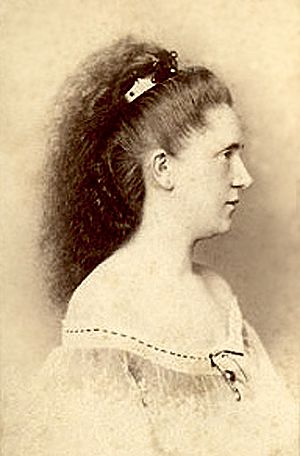Ingeborg Bronsart von Schellendorf facts for kids
Quick facts for kids
Ingeborg Bronsart von Schellendorf
|
|
|---|---|

Ingeborg Bronsart
|
|
| Born |
Ingeborg Maria Wilhelmina Starck
24 August 1840 Saint Petersburg, Russia
|
| Died | 17 June 1913 |
| Occupation | Finnish-German composer |
Ingeborg Bronsart von Schellendorf (born Ingeborg Maria Wilhelmina Starck) was a talented Finnish-German composer. She was born on August 24, 1840, in Saint Petersburg, Russia. She passed away on June 17, 1913, in Munich, Germany. Ingeborg became well-known for her beautiful operas, piano music, and many songs.
Contents
A Musical Life
Ingeborg Starck grew up in Saint Petersburg, Russia. Her parents, Margareta Åkerman and Otto Starck, were from Finland. Her father worked as a saddle-maker for the court. From a very young age, Ingeborg showed a great gift for music.
Early Studies
She began learning piano with Nicolas von Martinoff and Adolf von Henselt. She also studied how to compose music with Constantin Decker. Later, she finished her studies in Weimar, Germany, with the famous composer Franz Liszt.
Meeting Famous Composers
In 1861, Ingeborg visited Paris, France. There, she met many other famous composers. These included Daniel Auber, Hector Berlioz, Gioachino Rossini, and Richard Wagner. Wagner even wrote about her good looks in his autobiography! In September of that same year, she married a fellow pianist and composer named Hans Bronsart von Schellendorff. They had met in Weimar and were both part of Liszt's group of friends.
A Busy Career
After getting married, Ingeborg became known as Ingeborg Bronsart von Schellendorf. She traveled all over Europe as a concert pianist. She performed many shows until 1867. At that time, her husband became the general manager of the Royal Theatre in Hanover. It was expected that she would stop working as a performer.
However, Ingeborg continued to be very active in music. She composed many pieces, including operas, chamber music, and a large number of songs. Earlier, in 1863, she had composed a piano concerto. Sadly, this piece is now lost. During her lifetime, her operas were performed successfully in many theaters across Germany.
Popular Works
Some of her most popular pieces included the Kaiser Wilhelm March (composed in 1871). She also wrote a fun musical play called Jery und Bätely (1873). Another well-known work was her opera Hiarne (1891).
Main Works
Ingeborg Bronsart von Schellendorf wrote many different kinds of music. Here are some of her most important works:
Operas
- Die Göttin von Sais (1867)
- Jery und Bätely (1873)
- König Hiarne (1891)
- Die Sühne (1909)
Concertos
- Concerto for Piano and Orchestra in F-minor (1863)
Orchestral Music
- Kaiser Wilhelm March (1872)
Chamber Music
Chamber music is written for a small group of instruments.
- Romanze in A minor for violin and piano (1873)
- Notturno in A minor for cello and piano, op. 13 (1879)
- Elegie in C major for cello and piano, op. 14 (1879)
- Romanze in B-flat major for cello and piano, op. 15 (1879)
- Phantasie for violin and piano, op. 21 (1891)
Piano Music
- Trois études (1855)
- Nocturne (1855)
- Tarantella (1855)
- Kaiser Wilhelm March (1871)
- Vier Clavierstücke (1874)
- Drei Phantasie in G-sharp minor, op. 18 (1891)
Choral Music
Choral music is written for a choir, which is a group of singers.
- Hurrah Germania! for male choir (1871)
- Kennst du die rothe Rose? for soloists male choir and mixed choir (1873)
- Easter Lied, for choir, op 27 (1903)
Songs
Ingeborg Bronsart wrote many songs, often setting poems to music. Here are a few examples:
- Die Loreley (1865) (Text by Heinrich Heine)
- Und ob der holde Tag vergangen (1870)
- Five Lieder (1878) (Texts by Johann Wolfgang von Goethe, August von Platen, Friedrich Rückert)
- Six Lieder by Mirza Schaffy, op 8 (1879) (Texts by Friedrich Martin von Bodenstedt after Mirza Shafi Vazeh)
- Five Christmas Lieder, op 11 (1880)
- Five Poems, op. 16 (1882) (Texts by Ernst von Wildenbruch)
- Twelve Nursery Rhymes, op 17 (1882) (Texts by Klaus Groth)
- Blumengruss (1888) (Text by Goethe)
- Six Poems, op 20 (1891) (Texts by Mikhail Lermontov)
- Rappelle-toi! op. 24 (1902) (Text by Alfred de Musset)
- Abschied, op. 26 (1902) (Text by Felix Dahn)

